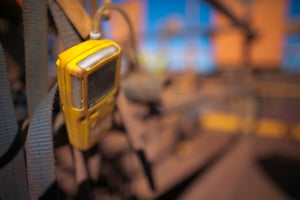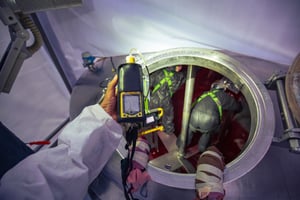When conducting gas tests in environments like confined spaces, it is crucial to follow a specific...
The Requirement of Oxygen for Catalytic Sensors
Catalytic gas sensors are widely used for detecting combustible gases in industrial and safety applications. However, it's crucial to understand their limitations and specific operating requirements to ensure accurate measurements and proper use. Let's explore why catalytic gas sensors require oxygen, measure in %LEL, and are unsuitable for purging applications.
Oxygen Dependency of Catalytic Gas Sensors
Catalytic gas sensors rely on the principle of catalytic oxidation to detect combustible gases. The sensor contains a catalyst-coated element that facilitates the oxidation of flammable gases when they come into contact with it. This oxidation reaction produces heat, which is then measured and converted into an electrical signal proportional to the gas concentration.
For this oxidation reaction to occur, oxygen must be present in the atmosphere. Typically, catalytic sensors require a minimum oxygen concentration of about 10-12% by volume to function correctly. Without sufficient oxygen, the sensor cannot accurately detect or measure combustible gases, potentially leading to false readings or failure to detect dangerous gas levels.
Measurement in %LEL
Catalytic gas sensors are designed to measure gas concentrations in terms of %LEL (Lower Explosive Limit). The LEL is the minimum concentration of a gas in air that can ignite and sustain combustion when exposed to an ignition source. For example, the LEL for methane is 4.4% by volume in air (IEC80079-29-1:2019).
Measuring in %LEL is particularly useful for safety applications because it directly relates to the flammability risk of the gas. A reading of 100% LEL indicates that the gas concentration has reached its lower explosive limit, while 50% LEL would represent half of that concentration, making %LEL a measurement of flammability. This measurement scale allows for quick assessment of potentially dangerous situations and helps establish safety thresholds.
Limitations in Purging Applications
Purging is a process used to remove or displace a hazardous gas from a confined space or system, often by introducing an inert gas like nitrogen. This process creates an oxygen-deficient environment, which poses a significant challenge for catalytic gas sensors:
1. Lack of oxygen: As mentioned earlier, catalytic sensors require oxygen to function. In a purged environment with little to no oxygen, these sensors cannot operate effectively or provide accurate readings.
2. Measurement range: Purging applications often require measuring gas concentrations well above the LEL range, sometimes up to 100% by volume. Catalytic sensors are typically designed to measure only up to 100% LEL, which is far below the concentrations encountered during purging.
3. Risk of sensor damage: Exposure to very high gas concentrations of flammable gas can potentially damage or degrade the catalytic sensor, affecting its long-term performance and reliability.
Alternative Solutions for Purging Applications
For purging applications or measurements in oxygen-deficient environments, alternative sensor technologies are more suitable:
1. Infrared (IR) sensors: These sensors can measure gas concentrations in % volume and do not require oxygen to function. They are ideal for measuring high gas concentrations and can operate in inert atmospheres.
2. Thermal Conductivity (TC) sensors: These sensors can measure gas concentrations up to 100% volume and are not affected by the absence of oxygen.
Conclusion
While catalytic gas sensors are excellent for detecting combustible gases in normal atmospheric conditions, they have limitations that make them unsuitable for purging applications. Their reliance on oxygen, measurement in %LEL, and potential for damage at high concentrations necessitate the use of alternative technologies in oxygen-deficient environments or when measuring high gas concentrations.
Understanding these limitations is crucial for selecting the appropriate gas detection technology for specific applications, ensuring accurate measurements, and maintaining a safe working environment.








